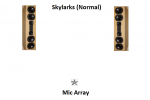I have posted before about a small nested line-array speaker that I designed and built, which I call the Skylarks. These speakers are typically listened to vertically, where they have wide horizontal dispersion, but limited vertical dispersion. However, they are sufficiently small that they can be turned on their side as well. In the sideways orientation, they produce wide vertical dispersion and limited horizontal dispersion. I have done sighted listening tests where I have rotated the speakers back and forth. This isolates for a lot of variables since it's the same speakers in the same place in the same room, with the same frequency response, the same crossover parts, the same dynamic range and distortion profiles. Everything is the same except the dispersion pattern. I have repeated this test for a very limited number of people.
I have also been working on a microphone array using 5 cardioid mics arranged equally around a circle. It's my intention to couple that design with significant post-processing to allow fairly narrow spatial filtering. As a proof-of-concept, I wanted to see if the mic array could capture the difference in sound of the skylarks in their normal (vertical) orientation as compared to in their sideways (horizontal) orientation. I recorded the same song with the same array in the same spot, played a the same level, and only changed the speaker orientation. Although I'm still working out some issues that are preventing me from finalizing the post-processing, I determined that simply mixing the forward three mics into a stereo recording is fairly demonstrative of the impact.
I have attached 2 diagrams showing the speaker orientation change. I have also linked 2 recordings (flac). I have time aligned them sufficiently so that an abx plug-in can be used to switch back and forth between the two in real-time. I roughly level matched them by reducing the level of the recording from the horizontal orientation by 2dB. The reason for this is that the floor and ceiling are closer than the sidewalls, and thus the vertical reflections add more reinforcement than the horizontal ones. Feel free to do a better level matching if you find it necessary.
If you're interested, take a listen and post your impressions comparing and contrasting the recordings. What I'm most interested in are the implications for how speakers ought to radiate sound into a room. Your listening should be done with headphones since there has already been one set of speakers and a whole room added to the chain.


I have also been working on a microphone array using 5 cardioid mics arranged equally around a circle. It's my intention to couple that design with significant post-processing to allow fairly narrow spatial filtering. As a proof-of-concept, I wanted to see if the mic array could capture the difference in sound of the skylarks in their normal (vertical) orientation as compared to in their sideways (horizontal) orientation. I recorded the same song with the same array in the same spot, played a the same level, and only changed the speaker orientation. Although I'm still working out some issues that are preventing me from finalizing the post-processing, I determined that simply mixing the forward three mics into a stereo recording is fairly demonstrative of the impact.
I have attached 2 diagrams showing the speaker orientation change. I have also linked 2 recordings (flac). I have time aligned them sufficiently so that an abx plug-in can be used to switch back and forth between the two in real-time. I roughly level matched them by reducing the level of the recording from the horizontal orientation by 2dB. The reason for this is that the floor and ceiling are closer than the sidewalls, and thus the vertical reflections add more reinforcement than the horizontal ones. Feel free to do a better level matching if you find it necessary.
If you're interested, take a listen and post your impressions comparing and contrasting the recordings. What I'm most interested in are the implications for how speakers ought to radiate sound into a room. Your listening should be done with headphones since there has already been one set of speakers and a whole room added to the chain.



